The adult female Bullfinch
was in the woods with 2 juveniles and at night the Tawny Owls were heard.
30th: At mid-day there was a Willow Warbler beside Treshnish wood, soon they will almost all be gone.
Later there was a flock of about 40 Siskins flying around the wood and 3 or 4 Bullfinches along the road beside Treshnish wood. They were all appeared to be juveniles.

Swallows are still being fed by adults.
The Kestrels have been hanging around Treshnish wood the last couple of days.
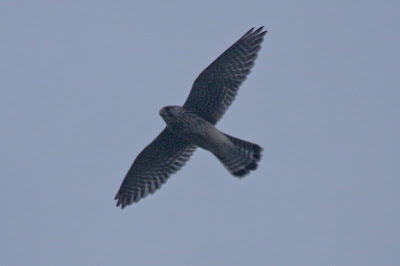
I wonder if they will take fancy to the owl box.
In the evening a Golden Eagle flew over Treshnish wood. I ran out but it had gone but I did see a Sparrowhawk
trying to harass a Kestrel.
I think both of them may have been young because they behaving as though they weren't sure what they were doing.
Then when I went inside along comes the female Golden Eagle but this time it stayed long enough for a shot.
1 Osprey over Ensay, see note for 6th Sept 2011 (my third record here the other 2 being in May).
A few rays of sun brought out a few butterflies, I was surprised to see this Dark Green Fritillary.
I haven't see one for weeks and this is my latest date (although I have a possible on 16 Sept 2006).
There was a Speckled Wood
and a Scotch Argus
but no Green-veined Whites or Meadow Browns.
The other day I wrote that most Fox Moth caterpillars are still very small. This was
already quite large.
These Common Darters have mated and now the female is laying eggs. She swings the tip of abdomen into the water although I am not sure who does the swinging.
This shows it better but isn't in focus.
This is an immature Blue-tailed Damselfly.
29th: A Wood Pigeon below Treshnish wood was the first for several weeks. So no breeding again this year. There was a Wheatear near the cow-barn. There were at least 4 Stonechats along the wall in Haunn field and 2 near the sitheans behind Treshnish Old Schoolhouse.
Again a pair of Golden Eagles between Beinn Duill and Treshnish wood. The male was perched behind Haunn cottages and on Cnoc an t-Sidhein. This is him
There was a male Reed Bunting in Black Park and presumably the same in Haunn field.
Pretty sure this is just a Curlew despite the clear eyebrow.
Usual suspects: Gannet
typical views of Manx Shearwater
and Great Skua
28th: A pair of Golden Eagles over and in Treshnish wood. This is the male
and this is the female
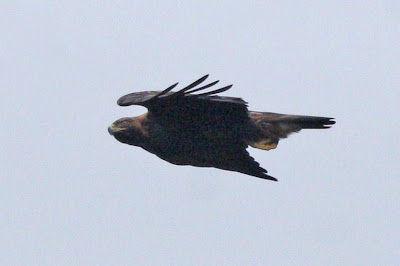
here she is diving at a Buzzard (which survived).
There were also at least 2 Bullfinches along the road through the wood. this is a juvenile.
27th: There was a female Hen Harrier right beside East cottage, Haunn and in the evening a Golden Eagle patrolling the coastal strip between Cruachan Treshnish and Ensay Burn.
26th: walkers saw a female Hen Harrier at Haunn.
Better late than never but I have re-identified a butterfly from last year. This is a Large Heath.
I have yet to find one on the Treshnish side of Ensay Burn but it is not common on the Ensay side either.
25th: In the morning there was a Hen Harrier near the summit of the Ensay-Burg road.
In the evening there was a covey of about 6 Red Grouse in the bog on the summit. Although I come across their droppings fairly often they are quite elusive in our area.
This is our residential race of Pied Wagtail. A White Wagtail does not have the dark grey spots on the light grey of the mantle.
At Treshnish Old Schoolhouse there was a Common Whitethroat (latest date at Treshnish is 3rd September).
Almost certain there was a Meadow Brown near Treshnish Old Schoolhouse (too orangey for Scotch Argus). Green-veined White are still on the wing
Managed to get a better shot of a flowering Bog Orchid.
24th: A female Hen Harrier flew from Cruachan Treshnish to Beinn Reudle.
At Treshnish lochan an immature Blue-tailed Damselfly
and on Cruachan Treshnish an Emerald Damselfly.
I also saw my first Black Darters of the year near Treshnish lochan but they were too flighty to photograph.
Tried to get a good photo of Bog Orchids. I could only find one clump of larger flowering plants but they were too shrivelled. This tiny plant came out OK.
22nd: A female Sparrowhawk flew along the south side of Treshnish wood. There was a Short-eared Owl at 8.30 before sunset near the summit of the Ensay-Burg road and walkers saw 2 ring-tailed Hen Harriers at Haunn.
There a lots of tiny froglets about but this is an adult Common Frog.
Sun in the afternoon brought out dragonflies and butterflies.
and mating Emerald Damselflies on the summit of the Ensay-Burg road. The female has missing segments to the abdomen so won't be able to reproduce. Normally the male first transfers sperm from the tip of his abdomen to his accessory genitalia at the front of his abdomen so this female would have needed to hook her abdomen all the way beneath her to touch his accessory genitalia. This creates the classic wheel. Right now the male is only holding her with his abdomen claspers, nothing else is happening.
A worn Speckled Wood
and one fresh
and a Meadow Brown. I am confused by the double spot but it can't be be a worn female Scotch Argus which would have a third spot and spots on the hindwing. This is my latest date for this species, the previous latest being on 19th August 2008.
Went to see how 2 nearby fruiting Narrow-leaved Helleborine were doing. This one looks great. I couldn't find the other (I will go back with a GPS).
The Broad-leaved Helleborone flowers are starting to drop
and it doesn't look as though they have been fertilized which is not surprising. The only other nearby flowering plant died after only moderate winds. This photo shows the plant with 2 very small vegetative plants of Narrow-leaved Helleborine at either end of the stick. The two species sometimes grow very close together in this woodland.
This Hazel Gloves fungus was very fresh
and this lovely coloured fungus is Amethyst Deceiver Laccaria amethystina.
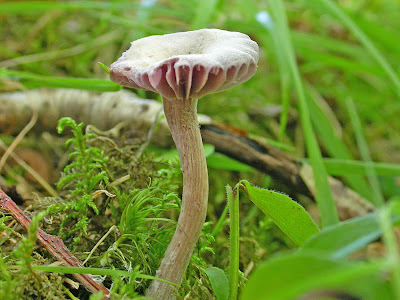
21st: A female Hen Harrier flew from Cruachan Treshnish to Beinn Reudle where it was joined by a male.
This Northern Eggar caterpillar was on Cruachan Treshnish. It is superficially similar to the very common Fox Moth but that darker and most are very small at this time of year and none are this big.
It is eating a flower of Cross-leaved Heath. These photos were taken 2 minutes apart.
20th: There were 3 House Martins around Treshnish farm buildings. I don't see any juvenile plumage on this bird. I wonder what the black spot on the side of the white rump is. I don't remember seeing any of the breeding birds with this mark.
One of them went to roost in the nest predated by House Sparrows.
First of all a pair were flying around the farm building looking at the the nests even the artificial one but one bird at least seemed to be most interested in the one that succeeded in producing at least one fledgling this year. The problem was this nest was accidentally knocked down by builders this week. After the roosting bird stayed put the second bird flew around for a bit and a few minutes later returned with a third bird. These birds didn't show any more interest in the nests and although I waited until quite late I didn't see them again.
This was a very familiar site (sorry it was taken into the sun).
I presume these are the birds that made nests this year but it is not definite. Last year whilst the pair still had chicks in the nest up to 10 birds appeared on the 24th and 30th of August and showed a lot of interest in the farm building including the artificial nest. Perhaps they were checking out sites for the following year and the birds today may have been doing the same.
There were 2 Whimbels flying east over Black Park field, between Treshnish and Haunn cottages. I am pretty sure they aren't Curlews.
Ruth Fleming and Stuart Gibson on day off from Mull Magic walks found a new species for the farm. Just after I had spoken to them they saw 3 Black-tailed Godwits land near Dun Haunn. Although Killiechronan is a regular site, I have only 2 records from nearby: [11 flew south past Calgary bay on 20/08/2010 & 1 on 23/08/2010 at Calgary, (Greg Pepper on www.mullbirds.com), 4 on 15/09/1988 at Calgary (Argyll Bird Report 5:22)]
18th: I caught a quick glimpse of some kind of ruckus on the edge of Treshnish wood. It involved a Kestrel, a Sparrowhawk and another raptor probably another Kestrel or Sparrowhawk. Going by the Kestrel alarm calls it may have been a Sparrowhawk attacking one of a pair of Kestrels or vice-versa.
There were at least 4 Bullfinches in Treshnish wood.
Tawny Owls calling again at dusk.
Still lots of Scotch Argus by Treshnish wood.
17th: No Hen Harriers seen today. Best Birds today were 2 Lapwings, which are not common at Treshnish.
and another good find was a couple of Stonechats. Terrible photo but its a rarity this year!
It has been very bad for Stonechats and Grey Wagtails on Mull this year. Presumably this is due to the last 2 cold winters.
This Lesser Redpoll had a recently fledged youngster.
Went to see if I could find that Quail. I did flush a game bird but its mum turned out to be a Pheasant. Later I flushed another small game bird which was probably a Pheasant but it flew into cover.
Its almost that time to look for the last migrants. Today many of the usual suspects were seen: Swallow, Sand Martin, Whitethroat, Wheatear, Willow Warbler and Sedge Warbler,
this was a juvenile that was waiting for its parent to bring food
Tawny Owls calling again at dusk.
I am pretty sure I saw a Golden-ringed Dragonfly in flight by Treshnish Old Schoolhouse. If so that is my latest date. I will try and get a better view tomorrow to discount female Common Hawker.
I spent a lot of time looking for Lesser Twayblade at what looks like a perfect spot just outside the deer-fence on the road to Haunn. I didn't find any.
16th: Went to see if I could re-locate the Wryneck, which was a long shot as this is a skulking species but no luck.
More good news. Carolyne flushed a bird between Treshnish and Haunn cottages which she thinks was a Quail.
A good raptor day although mostly quick, distant views. In the morning a probable Merlin was diving at a Raven at Treshnish Old schoolhouse.
A White-tailed Eagle flying west around Treshnish Point.
A Golden Eagle flying from Cruachan Treshnish towards the boathouse (this is the female).
Sparrowhawk(s) at Haunn field and treshnish Point.
Hen Harrier near the entrance from Black Park to Haunn field. This shot was with 2 Buzzards (the harrier is on right)
which resulted in this Buzzard doing a half roll.
and more Buzzards.
Got a better male Reed Bunting shot today
and what I think is a juvenile.
A Whinchat was still around between Haunn and the north coast.
Also a Dunnock fledgling.
Again Tawny Owls were heard in the evening at Treshnish Old Schoolhouse.
Carolyne took photographs of the Field Gentians which she has posted here and I saw she had found many I had missed. So the hillock where I reported 350+ actually has probably more than 600 plants!
I think this must be a Harebell.
15th: I have had confirmation that this a Wryneck which flew from the fence of the reeds area below Toechtamhor cottage, to some bracken just to the west. This is the third record for Mull and the earliest post breeding record for Argyll which has only had ten records since 1969!
Immediately I saw it on the fence post, I thought 'Cuckoo, no too small and then, Wryneck!' The posture was right (horizontal) and the plumage was obviously something unusual. I immediately took a shot as the bird flew. Luckily it landed close by and didn't disappear into the vegetation immediately but after 2 shots I couldn't see it at the spot where it landed although I saw a bird hidden on a thistle a yard away which I thought must be it. I waded across the bog to get closer and eventually saw it was just a Goldfinch. Then I forgot about it as I was preoccupied with trying to get Hen Harrier shots. When I got home I was worried the photo was not good enough. Could it have been a shrike? I was pretty sure it wasn't just from the jizz (general shape and appearance). Luckily the photograph was good enough, phew.
Previous Mull records were 1 from 9 to 10 June 1991 at Torlochan and 1 on 14 May 2001 at Croig. The Croig bird was the last for Argyll (as of 2007).
Today 2 Hen Harriers in the fields around Haunn.
For once I can say I am happy with these photos
There was a female Sparrowhawk there too.
and I always thought Reed Buntings only ate seed but this juvenile was fly-catching
I guess it hasn't read the books because here it is trying to eat a feather it caught.
It was very tame
not like the adult male (and adult female?)
This Swallow in the reedbed was begging for food.
2 presumed Red-throated Divers flew around Treshnish Point.
There were over 50 Twite in the evening around Treshnish House
Back at the cow-barn a Kestrel gave me my best shots so far.
I was also told of a Peregrine seen at Treshnish Old Schoolhouse.
There was at least 1 House Martin with the Swallows at Treshnish house, which may be the juvenile from here.
As I type a Tawny Owl calls outside our window. haven't heard it for a while.
This Shaded Broad-bar moth is only my first since 2008. I have only 8 previous records 1 in 2006, 5 in 2007 and 2 in 2008. It came to the light trap only twice, all other records were during the daytime.
and this Common Blue is quite late, even though my lastest is on 9th Sept in 2009. My other latest was on 17th August last year.
I found another patch of 220+ Field Gentians just to east of the reedy area below Toechtamfor at a new site.
This is a Threatened plant and its success at Treshnish should be enough to pursuade you to vote for Treshnish to win the RSPB Nature Of farming award, if you haven't already done so (see top). There are at least 14 in this small square.
14th: Again a female Hen Harrier between Treshnish boathouse and Treshnish Point for at least an hour and a quarter. It didn't come as close as I hoped but better than yesterday.
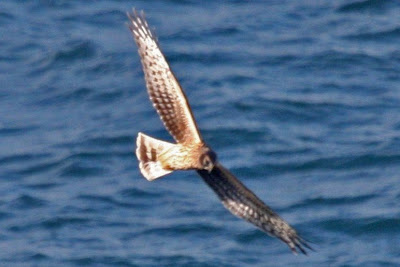
A Sparrowhawk flew over Treshnish cow-barn to the wood below.
Usual suspects Twite.
There was a Mountain Hare in Skoma field.
Found my first ever Cinnabar Moth caterpillars.
This moth feeds exclusively on ragwort. These were on Marsh Ragwort in a wet fenced off, tree planted area. I would have thought the colour alone would be enough to put off predators but some of them, when they saw me, raised the front half of their bodies and jerked it violently back and forth, sideways.
Went back to get the grid-reference for yesterdays Field Gentians. I counted at least 350 and it is totally new site! Nearby there were another 300, also a new site! My highest count previously was 102 but usually there are only 1-30 at a site.
13th: Again a female Hen Harrier in Black Park and Skoma fields. In the evening I went back with a camera and after a short while it flew by from Treshnish Point towards Treshnish cow-barn but it wasn't as close as in the afternoon or yesterday.
Just before sunset a House Martin flew into the successful nest at Treshnish House. I approached the nest to try to get a shot and see how many there were but I disturbed it and 1 flew out. There were no more inside and after a minute or so it went back inside but only after several attempts. It also showed interest in the artificial nests beside their nest. I think because of this hesitancy it was the juvenile.
The Kestrels have moved way from their nesting cliffs and are starting to give photographic opportunities.
I will have to spend more time on this but at first glance it looks like the spider-hunting wasp, Ceropales maculata.
I found over 70 Field Gentians on the side of the hillock at the top end of Skoma field near the gate into Haunn field. I didn't have my GPS with me but if I have seen them here before it certainly wasn't in such high numbers. There were also smaller numbers at other spots nearby. This is almost certainly due to the late grazing in this field this year. Whilst seeing the cows slowly slowly nibble the Field Gentians in Haunn field this year, is hard to see, it just means that numbers are flourishing in other areas. This is especially true as there are at least 30 sites with Field Gentian on the farm. The cows have just been moved from a field where I found three new sites whilst the cows were still present, so those should set seed. Field Gentian also prefers a short sward and cows are more likely to feed on longer grass so probably leave some plants to set seed. This year does seem like an excellent Field Gentian year.
12th: There was a female Hen Harrier in Black Park and Skoma fields and 3 Bullfinches at the entrance to Black Park field, between Treshnish and Haunn cottages. There was a Mountain Hare in the garden by Duill cottage.
9th: There was a cream coloured Swallow with Swallows and a couple of House Martins at Bennan farm, Calgary which was last seen over the house at Langamull. I am not 100% certain that it wasn't a martin.
A male Hen Harrier was over Bennan.
A pair of White-tailed Eagles at Cillchriosd.
Usual suspect: Wheatear
There was an Otter on the west side of Lainne Sgeir, Calgary and a Mountain Hare at Bennan.
8th: Now the young have fledged I went to see if I could find the Short-eared Owl nest. I didn't find it but I did find a few feathers and the roost sites of an adult. These are the pellets at the roost sites.
and a perch site of an adult with pellets and a feather on a rock.
It is not very often I get such a close view of a Hen Harrier but this female flew immediately it landed and before the autofocus could find it.
Two and a half hours later I saw another near the ruins behind Treshnish Old Schoolhouse.
having a scratch
They could have been 2 different birds. The upperwing patch appears to be wider and more rufous in the first bird.
There was a Golden Eagle over Cruachan Treshnish and about 2 and a half hours later, 1 over Beinn Reudle.
Found some more Lesser Twayblade sites behind our house but again none with flowers.
I found some Bog Orchid bulbils at the site closest to Treshnish House. I couldn't find any last year but if they don't flower they are very hard to see.
The submerged leaves on the above photo are of a bladderwort species (you can also see the bladder).
I mentioned I only knew very few sedges etc. This one I do know, it is White-beaked Sedge.
7th: A pair of Golden Eagles were hunting along the coastal strip. favourite perches were the hillock above Treshnish lochan and Cnoc an t-Sidhein (the hill half way between Treshnish and Haunn cottages). The larger bird is the female.
I think these are all of the male
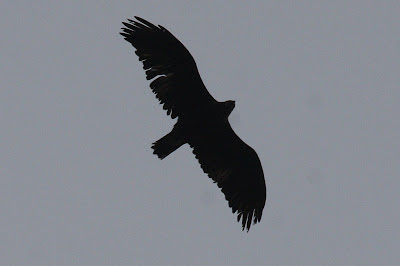
15 Greylags flew to Skoma field from the Port Haunn direction and later 2 more were above Haunn.
I have not mentioned Greyags for several weeks because I haven't seen any at Treshnish.
There were 3 Whinchats at Haunn field.
There was a Hen Harrier at the summit of the Ensay-Burg road.
This Kestrel appears to have caught an insect, perhaps a moth.
Guests at Duill cottage saw a Redshank in front of Toechtamhor cottage and on about the 4th, one at the pond at Duill.
6th: A juvenile chat before the gate into Haunn field may have been a Stonechat. The first all summer if not all year! Went to see if the Short-eared Owls were flying earlier and giving photographic opportunities but only 1 was seen briefly at 9.30pm. I presume they must be flying in the middle of the day. I will try for an early morning soon. Guests at Shian cottage saw a Tawny Owl at about 10pm above the owl box half way to Haunn cottages.
5th: There was at least 1 House Martin fledgling with its parents around Treshnish House and for a while all together on Duill cottage roof. At one time I thought I saw 5 together but they may have been Sand Martins. I only ever saw 1 chick poking its head out of the nest so perhaps they only managed to rear 1 young.
Last night was so sultry it seemed like the perfect night for moths so I ran the moth trap for the first time this summer. I only ran it for about 4 hours and later the wing picked up but although the catch wasn't too bad they were mostly of 2 species.
The most interesting was this beautiful Ingrailed Clay
and for scarcity this Scotch Annulet. I usually catch only 1 or 2 of these per year (never more). It is a Nationally Scarce B (Nb) species, i.e. recorded in less than 100 10x10km squares in Great Britain since 1980.
Bleached Pug is another Nb species at Treshnish (I caught 5 in 2007 and 1 in 2010) and Transparent Burnet is even more scarce (Na) i.e. recorded in under 30 10x10km squares (some years abundant at certain sites at Treshnish) whilst The Grey is a Red Data species i.e. known from under 15 10x10km squares (I have only caught it twice).
4th: This Lesser Yellow Underwing was found inside our house. I don't remember seeing one so beautiful.
On the 2nd I went looking for the fungi I posted a photograph of on the 19th July, to see if it looked different when open but I couldn't find it and haven't been able to identify it. So I asked for help and I have been told by an expert that it is Amanita battarrae, (also known as A. umbrinolutea) which is rare in Britain although it has been recorded on Mull before but not shown on this map.
3rd: An adult White-tailed Eagle was on Cnoc a' Chaisteil and Beinn Bhuidhe for over 3 hours in the afternoon. It was checked out by a ring-tailed Hen Harrier and was watched over by a Golden Eagle for part if not all of the time. I am pretty sure it was also there yesterday going by the noise the Buzzards and Ravens were making. Today it was the yellow tagged C. Too far away for decent photographs but at x60 with a telescope the tags were quite clear. This was from 1.5km away (just under a mile).
Still lots of Lesser Redpoll in the wood.
Usual suspects include this Buzzard.
These Green-veined White were mating. I understand the yellow one is a second brood female.
After a frantic struggle they managed to separate
Also good numbers of Speckled Wood
and Scotch Argus with a few Meadow Browns.
I had the results back today of a rare grass I found on the Ross on the 4th of July (see that date for photos). I thought it was Sea Fern-grass Catapodium marinum but I was told it could even be Fern-grass Catapodium rigidum which is un-recorded on Mull. It turns out it is Sea Fern-grass which is still very rare on Mull. I should point out that I know next to nothing about grasses and sedges etc. in fact I can identify only a handful of species but this one was so unusual I gave it a go and as it happens on Mull, it was a rarity!
Also the vetch from 4th of July, that I thought was Common Vetch Vicia sativa is also confirmed and that is a new plant for me. I thought perhaps I was overlooking this species because I see now that the Mull Flora hast is as 'occasional; a few scattered localities' and lists the north-west as one of the regions but survey work for the new flora by Lynne Farrell and team does not, as far as I am aware, have any records for the northwest so it must be rare at least in this part of Mull.
2nd: Bullfinches as usual in Treshnish wood but today an adult male was also seen.
Usual suspect: Blackbird.
The nearest Broad-leaved Helleborine is dying but this one is fine.
I have been reading up on the reproductive process. I think I have this right. The white ball is a sac of glue. When a wasp lands on the lip and its head touches the sac, it burst and the glue sticks to the wasps head.
Then when the wasp touches the pollinia (stacks of pollen), it attaches to the wasp which carries it to the next plant where fertilization takes place.
The pollinia are the 2 pale yellow banana shaped structures above the white ball. The anther is the greeny yellow structure above them and stigma is the shiny rectangular shaped structure below the white ball or viscidium.
I know I have a better photo somewhere but this Marbled Coronet has what I think are pollinia stuck to its head but from a different orchid species.
and on this Large Yellow Underwing
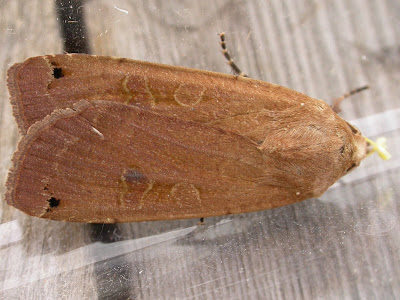
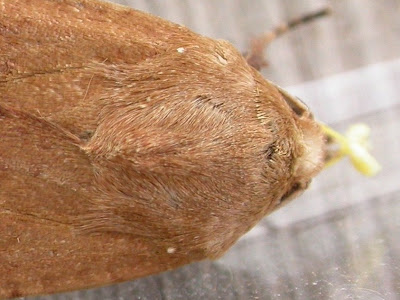
1st: Below Treshnish House there were at least 2 terns fishing. Both Common Tern
and the 2 photos below of Arctic Tern.
On the photo below notice the sharper dark line at the tips of the primaries (outer flight feathers) and the pale patch inside of it and also the smaller white line between the bill and the cap and a white contrasting line between the cap and the more grey belly.
here the tip of the wing has none of the dark wedge of Common Tern and the neck is shorter. The short neck creates the 'front heavy' profile of Arctic compared to the more balanced of Common, which is mentioned in the books.
There were several mixed flocks between the cow-barn and the Studio, including many Twite, you can just see the pink rump of the male on the right
at least 1 Reed Bunting
and Siskins.
I think this is a House Sparrow chick at the cow-barn
This Sedge Warbler, along the shore below Treshnish House, must have had chicks or fledglings nearby
The House Martins must have fledged. Normally I can get them to poke their heads out when I make squeaking noises. I haven't seen them at the nest since the 30th.
There was a small pod of dolphins probably Bottle-nosed Dolphins out from below Treshnish House. When I went down to the shore they had already moved to Treshnish point.
A still cloudy day allowed close up shots of Scotch Argus
There are still some Meadow Browns, and some look quite fresh
Along the shore below Treshnish House, a mature Blue-tailed Damselfly
and I think an immature
The nearby Broad-leaved Helleborine has been hit hard by what was only a moderate wind for Mull
There was some Marsh Cudweed by Treshnish House. This seems to be an under recorded plant on Mull. I have found it in several places along farm tracks.
and Field Gentian by Ensay Burn mouth.
This was in the vegetable garden. I think it is Fat Hen, a new, but not very exciting, plant for Treshnish.

